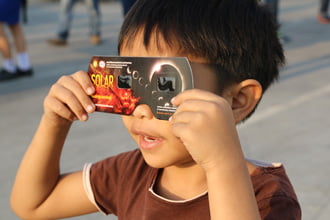
August 2017 — Later this month, an astronomical event will be viewable in the United States that hasn’t occurred here for nearly 100 years: a total solar eclipse.
On August 21, the moon will shade virtually the entire sun over a roughly 70-mile-wide band extending from Oregon to South Carolina. The last time a total eclipse of the sun affected such a large area of the country was back on June 8, 1918, when an eclipse extended from Washington State to Florida.
Within this “band of totality,” eclipse watchers will see the moon completely shade the sun (a total eclipse). In areas of the country outside this band, watchers will see the moon pass in front of much of the sun, but not cover it completely (a partial eclipse).
Regardless where you plan watch the upcoming 2017 solar eclipse, it’s essential you wear disposable protective “eclipse glasses” to adequately shield your eyes from the sun’s harmful UV radiation and high-energy visible light.
When purchasing these protective shades (which are many times darker than sunglasses), buy them from a reputable source and make sure they meet the ISO 12312-2 international standard for safe direct viewing of the sun.
Learn more about the 2017 solar eclipse and protective eclipse glasses. — G.H.
[ Source : allaboutvision ]
